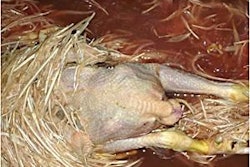The U.S. Department of Agriculture Food Safety and Inspection Service’s proposed poultry slaughter rule allows plants a choice of continuing with traditional inspection or changing to a new HIMP-like system, said Kendra Waldbusser, senior vice president, food safety and quality assurance, Pilgrim’s Corp. Speaking at the Chicken Media Summit in New Bern, N.C., she said that the HACCP-based Inspection Models Project, known as HIMP, was a pilot program with 20 broiler plants participating over a period of 14 years. Waldbusser said that Pilgrim’s Pride operates five of the 20 HIMP plants.
She characterized the proposed inspection system as one that “differs slightly from HIMP.” In the new system, plant personnel would conduct carcass sorting before USDA inspection. One USDA inspector would be assigned to each evisceration line, and they would be stationed just before the chiller. The regulation would allow for line speeds up to 175 birds per minute for young chickens. Under current rules, the maximum speed for so-called new technology lines is 140 birds per minute, but HIMP plants have operated successfully at speeds up to 175 birds per minute. Evisceration lines of this type are running at up to 200 birds per minute in Europe and Brazil.
Other changes
The new inspection program would remove the existing finished product standards, many of which are not food safety related, and instead require establishments to maintain procedures ensuring that products meet the definition of ready-to-cook poultry. Waldbusser cited the example of the current finished product standard for feathers on carcasses, which is not a food safety issue and is irrelevant for skinless product, and can be handled by company quality standards.
The USDA proposes removing the old chilling requirements for carcasses and instead would require plants to incorporate their own procedures for chilling. “USDA is saying that everyone’s process is different,” she said. “A plant that puts product in a tray immediately after the chiller may want a different temperature for that bird than would a plant that sends a carcass to deboning and further processing after the chiller. They put the burden of the data gathering and validation of the process back on the processor.”
Waldbusser said that by the USDA taking many of its employees off the evisceration line, the agency can increase its focus on offline inspections, such as HACCP records reviews and other food safety related tasks. The inspectors no longer needed on the evisceration lines could be trained and used for these offline inspections.
Common misconceptions
Waldbusser said that there are some misconceptions about what the impact of the changes to poultry inspection will be. She has seen reports that line speeds will increase fivefold. “This isn’t true,” she said. Under current programs, the maximum number of birds per minute that an individual inspector must look at is 35 birds per minute. Plant personnel will replace USDA inspectors at these positions. If the line is operated at 175 birds per minute, then the one inspector at the end of the line would be double checking the work of the plant at that speed, but they would not be responsible for inspecting each carcass and viscera pack at 175 birds per minute.
Under the proposed rule, the USDA inspector would have to be notified before a new flock is slaughtered to allow for inspection of the viscera of the first 300 birds. This dispels the myth that USDA personnel will not inspect any viscera.
Another invalid concern Waldbusser said she has seen is that as soon as the new inspection program is approved, all broiler plants could just flip a switch and operate at 175 birds per minute. Even plants with the new evisceration systems that could run at 175 birds per minute may not have the infrastructure in place in the rest of the plant to accommodate running at that speed. She explained that you can’t just slaughter birds at the higher speed; you also have to be able to chill them and process them on the other side of the chiller. In addition, the live operations supplying the plant would need to be expanded, unless a decision was made to process the same number of birds in fewer hours and not process more birds. She explained that you may need to reengineer your plant to go to faster line speeds, and for some plants it might not be feasible. “It takes two years to substantially change your complex,” she said.
Another misconception that Waldbusser said she has heard is that the new inspection program would be mandatory. “This is not the case, and plants are given the option,” she said. They can continue in traditional inspection.
The 14 years of experience at the 20 HIMP plants help to dispel two other myths about the proposed new inspection system, according to Waldbusser. Some have said that the increase in line speed allowed for in the proposed rule will be harmful to employees. She said that the data gathered at the 20 HIMP plants have shown that this is not true. Also, some have suggested that defect rates will increase under the new system. Waldbusser said, “The HIMP pilot started 14 years ago has demonstrated this is not the case.” She said that no HIMP plant has ever needed any enforcement action by the USDA.


















